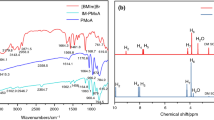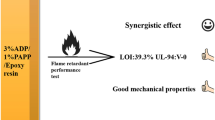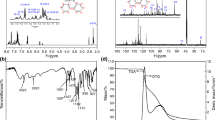Abstract
In order to improve the flame retardancy and smoke suppression of epoxy resin (EP) simultaneously, we synthesized a melamine phenylhypophosphonate named as MABP via a simple one-step method and used it to modify EP materials. As expected, the addition of MABP not only largely improved the flame retardancy but also restrained the smoke release of EP. For details, when the content of MABP was 10 wt%, the EP composite possessed a limiting oxygen index value of 33% and achieved to a UL-94 V-0 rating as well as its PHRR, THR and TSP values decreased by 55.1%, 27.1% and 60% compared with that of neat EP, respectively. In addition, the flame-retardant mechanism was investigated by multiple instruments, and the corresponding results exhibited that the MABP could improve the compactness of char layer in condense phase and exerted fire-inhibition effect in gaseous phase.
Graphic abstract












Similar content being viewed by others
References
Huo SQ, Liu ZT, Wang J (2020) Thermal properties and flame retardancy of an intumescent flame-retarded epoxy system containing phosphaphenanthrene, triazine-trione and piperidine. J Therm Anal Calorim 139:1099–1110. https://doi.org/10.1007/s10973-019-08467-3
Zhu ZM, Shang K, Wang LX, Wang JS (2019) Synthesis of an effective bio-based flame-retardant curing agent and its application in epoxy resin: curing behavior, thermal stability and flame retardancy. Polym Degrad Stab 167:179–188. https://doi.org/10.1016/j.polymdegradstab.2019.07.005
Ai YF, Xia L, Pang FQ, Xu YL, Zhao HB, Jian RK (2020) Mechanically strong and flame-retardant epoxy resins with anti-corrosion performance. Compos B 193:108019. https://doi.org/10.1016/j.compositesb.2020.108019
Yu B, Xing WY, Guo WW, Qiu SL, Wang X, Lo SM, Hu Y (2016) Thermal exfoliation of hexagonal boron nitride for effective enhancements on thermal stability, flame retardancy and smoke suppression of epoxy resin nanocomposites via sol-gel process. J Mater Chem A 4:7330–7340. https://doi.org/10.1039/C6TA01565D
Grause G, Karakita D, Ishibashi J, Kameda T, Bhaskar T, Yoshioka T (2011) TG-MS investigation of brominated products from the degradation of brominated flame retardants in high-impact polystyrene. Chemosphere 85:368–373. https://doi.org/10.1016/j.chemosphere.2011.06.104
Wang JQ, Chow WK (2005) A brief review on fire retardants for polymeric foams. J Appl Polym Sci 97:366–376. https://doi.org/10.1002/app.21758
Wang X, Hu Y, Song L, Xing WY, Lu HD (2011) Thermal degradation mechanism of flame retarded epoxy resins with a DOPO-substitued organophosphorus oligomer by TG-FTIR and DP-MS. J Anal Appl Pyrol 92:164–170. https://doi.org/10.1016/j.jaap.2011.05.006
Luo HQ, Rao WH, Zhao P, Wang L, Liu YL, Yu CB (2020) An efficient organic/inorganic phosphorus—nitrogen—silicon flame retardant towards low-flammability epoxy resin. Polym Degrad Stab 178:109195. https://doi.org/10.1016/j.polymdegradstab.2020.109195
Yang S, Zhang QX, Hu YF (2016) Synthesis of a novel flame retardant containing phosphorus, nitrogen and boron and its application in flame-retardant epoxy resin. Polym Degrad Stab 133:358–366. https://doi.org/10.1016/j.polymdegradstab.2016.09.023
Schartel B (2010) Phosphorus-based flame retardancy mechanisms—old hat or a starting point for future development? Materials 3:4710–4745. https://doi.org/10.3390/ma3104710
Levchik SV, Weil ED (2006) A review of recent progress in phosphorus-based flame retardants. J Fire Sci 24:345–364. https://doi.org/10.1177/0734904106068426
Shao ZB, Zhang MX, Li Y, Han Y, Ren L, Deng C (2018) A novel multi-functional polymeric curing agent: synthesis, characterization, and its epoxy resin with simultaneous excellent flame retardance and transparency. Chem Eng J 345:471–482. https://doi.org/10.1016/j.cej.2018.03.142
Tan Y, Shao ZB, Yu LX, Long JW, Qi M, Chen L, Wang YZ (2016) Piperazine-modified ammonium polyphosphate as monocomponent flame-retardant hardener for epoxy resin: Flame retardance, curing behavior and mechanical property. Polym Chem 7:3003–3012. https://doi.org/10.1039/C6PY00434B
Hu XP, Li YL, Wang YZ (2004) Synergistic effect of the charring agent on the thermal and flame retardant properties of polyethylene. Macromol Mater Eng 289:208–212. https://doi.org/10.1002/mame.200300189
Zhao X, Zhang L, Alonso JP, Delgado S, Martínez-Miranda MR, Wang DY (2018) Influence of phenylphosphonic amide on rheological, mechanical and flammable properties of carbon fiber/RTM6 composites. Compos Part B Eng 149:74–81. https://doi.org/10.1016/j.compositesb.2018.05.018
Zhu ZM, Wang LX, Dong LP (2019) Influence of a novel P/N-containing oligomer on flame retardancy and thermal degradation of intumescent flame-retardant epoxy resin. Polym Degrad Stab 162:129–137. https://doi.org/10.1016/j.polymdegradstab.2019.02.021
Shao XM, Du YQ, Zheng XF, Wang JC, Wang YC, Zhao S, Xin ZX, Li L (2020) Reduced fire hazards of expandable polystyrene building materials via intumescent flame-retardant coatings. J Mater Sci 55:7555–7572. https://doi.org/10.1007/s10853-020-04548-z
Dong LP, Huang SC, Li YM, Deng C, Wang YZ (2016) A novel linear-chain polyamide charring agent for the fire safety of noncharring polyolefin. Ind Eng Chem Res 55:7132–7147. https://doi.org/10.1021/acs.iecr.6b01308
Velencoso MM, Battig A, Markwart JC, Schartel B, Wurm FR (2018) Molecular firefighting—how modern phosphorus chemistry can help solve the challenge of flame retardancy. Angew Chem Int Ed 57:10450–10467. https://doi.org/10.1002/anie.201711735
Yang S, Wang J, Huo SQ, Wang M, Zhang WJPB (2018) Synergistic flame-retardant effect of expandable graphite and phosphorus-containing compounds for epoxy resin: strong bonding of different carbon residues. Polym Degrad Stab 128:89–98. https://doi.org/10.1016/j.polymdegradstab.2016.03.017
Xu YJ, Wang J, Tan Y, Qi M, Chen L, Wang YZ (2018) A novel and feasible approach for one-pack flame-retardant epoxy resin with long pot life and fast curing. Chem Eng J 337:30–39. https://doi.org/10.1016/j.cej.2017.12.086
Dittrich B, Wartig KA, Mülhaupt R, Schartel B (2014) Flame-retardancy properties of intumescent ammonium poly(phosphate) and mineral filler magnesium hydroxide in combination with grapheme. Polymers 6:2875–2895. https://doi.org/10.3390/polym6112875
Jian RK, Ai YF, Xia L, Zhao LJ, Zhao HB (2019) Single component phosphamide-based intumescent flame retardant with potential reactivity towards low flammability and smoke epoxy resins. J Hazard Mater 371:529–539. https://doi.org/10.1016/j.jhazmat.2019.03.045
Li P, Wang B, Xu YJ, Jiang ZM, Dong CH, Liu Y, Zhu P (2019) Ecofriendly flame-retardant cotton fabrics: preparation, flame retardancy, thermal degradation properties, and mechanism. ACS Sustain Chem Eng 7:19246–19256. https://doi.org/10.1021/acssuschemeng.9b05523
Camino G, Costa L, Martinasso G (1989) Intumescent fire-retardant systems. Polym Degrad Stab 23:359–376. https://doi.org/10.1016/0141-3910(89)90058-X
Yan YW, Chen L, Jian RK, Kong S, Wang YZ (2012) Intumescence: an effect way to flame retardance and smoke suppression for polystyrene. Polym Degrad Stab 97:1423–1431. https://doi.org/10.1016/j.polymdegradstab.2012.05.013
Bourbigot S, Le Bras M, Duquesne S, Rochery M (2004) Recent advances for intumescent polymers. Macromol Mater Eng 289:499–511. https://doi.org/10.1002/mame.200400007
Li B, Xu MJ (2006) Effect of a novel charring-foaming agent on flame retardancy and thermal degradation of intumescent flame retardant polypropylene. Polym Degrad Stab 91:1380–1386. https://doi.org/10.1016/j.polymdegradstab.2005.07.020
Wang JS, Wang DY, Liu Y, Ge XG, Wang YZ (2008) Polyamide-enhanced flame retardancy of ammonium polyphosphate on epoxy resin. J Appl Polym Sci 108:2644–2653. https://doi.org/10.1002/app.27522
Zhu ZM, Wang LX, Lin XB, Dong LP (2019) Synthesis of a novel phosphorus-nitrogen flame retardant and its application in epoxy resin. Polym Degrad Stab 169:108981. https://doi.org/10.1016/j.polymdegradstab.2019.108981
Chen MJ, Shao ZB, Wang XL, Chen L, Wang YZ (2012) Halogen-free flame-retardant flexible polyurethane foam with a novel nitrogen-phosphorus flame retardant. Ind Eng Chem Res 51:9769–9776. https://doi.org/10.1021/ie301004d
Gao LP, Wang DY, Wang YZ, Wang JS, Yang B (2008) A flame-retardant epoxy resin based on a reactive phosphorus-containing monomer of DODPP and its thermal and flame-retardant properties. Polym Degrad Stab 93:1308–1315. https://doi.org/10.1016/j.polymdegradstab.2008.04.004
Wang CS, Lin CH (1999) Synthesis and properties of phosphorus-containing epoxy resins by novel method. J Polym Sci A: Polym Chem 37:3903–3909. https://doi.org/10.1002/(SICI)1099-0518(19991101)37:21<3903:AID-POLA4>3.0.CO;2-X
Zhu ZM, Xu YJ, Liao W, Xu SM, Wang YZ (2017) Highly flame retardant expanded polystyrene foams from phosphorus-nitrogen-silicon synergistic adhesives. Ind Eng Chem Res 56:4649–4658. https://doi.org/10.1021/acs.iecr.6b05065
Chen YJ, Wang W, Qiu Y, Li LS, Qian LJ, Xin F (2017) Terminal group effects of phosphazene-triazine bi-group flame retardant additives in flame retardant polylactic acid composites. Polym Degrad Stab 140:166–175. https://doi.org/10.1016/j.polymdegradstab.2017.04.024
Wei YX, Deng C, Zhao ZY, Wang YZ (2018) A novel organic-inorganic hybrid SiO2@DPP for the fire retardance of polycarbonate. Polym Degrad Stab 154:177–185. https://doi.org/10.1016/j.polymdegradstab.2018.05.014
Wang PJ, Liao DJ, Hu XP, Pan N, Li WX, Wang DY, Yao Y (2019) Facile fabrication of biobased P–N–C-containing nano-layered hybrid: preparation, growth mechanism and its efficient fire retardancy in epoxy. Polym Degrad Stab 159:153–162. https://doi.org/10.1016/j.polymdegradstab.2018.11.024
Schartel B, Hull TR (2017) Development of fire-retarded materials—Interpretation of cone calorimeter data. Fire Mater 31:327–354. https://doi.org/10.1002/fam.949
Zhang CY, Zhao BC, Hao R, Wang Z, Hao YW, Zhao B, Liu YQ (2019) Graphene oxide-highly anisotropic noble metal hybrid systems for intensified surface enhanced Raman scattering and direct capture and sensitive discrimination in PCBs monitoring. J Hazard Mater 385:121510. https://doi.org/10.1016/j.jhazmat.2019.121510
Rao WH, Hu ZY, Xu HX, Xu YJ, Qi M, Liao W, Xu SM, Wang YZ (2017) Flame-retardant flexible polyurethane foams with highly efficient melamine salt. Ind Eng Chem Res 56:7112–7119. https://doi.org/10.1021/acs.iecr.7b01335
Jian RK, Wang P, Xia L, Zheng XL (2017) Effect of a novel P/N/S-containing reactive flame retardant on curing behavior, thermal and flame-retardant properties of epoxy resin. J Anal Appl Pyrol 127:360–368. https://doi.org/10.1016/j.jaap.2017.07.014
Ma C, Qiu SL, Yu B, Wang JL, Wang CM, Zeng WR, Hu Y (2017) Economical and environment-friendly synthesis of a novel hyperbranched poly(aminomethylphosphine oxide-amine) as co-curing agent for simultaneous improvement of fire safety, glass transition temperature and toughness of epoxy resins. Chem Eng J 322:618–631. https://doi.org/10.1016/j.cej.2017.04.070
Acknowledgements
This work was supported by Sichuan province Science and Technology Planning project (2018JY0534).
Author information
Authors and Affiliations
Corresponding authors
Ethics declarations
Conflict of interest
We confirm that the manuscript has been read and approved by all named authors. We declare that we have no conflict of interest.
Additional information
Publisher's Note
Springer Nature remains neutral with regard to jurisdictional claims in published maps and institutional affiliations.
Rights and permissions
About this article
Cite this article
Zhu, Z., Lin, P., Wang, H. et al. A facile one-step synthesis of highly efficient melamine salt reactive flame retardant for epoxy resin. J Mater Sci 55, 12836–12847 (2020). https://doi.org/10.1007/s10853-020-04935-6
Received:
Accepted:
Published:
Issue Date:
DOI: https://doi.org/10.1007/s10853-020-04935-6




